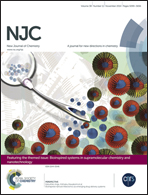Solid-phase synthesis and analysis of 3,6-dihydro-2H-1,2-oxazines in their stereo- and regioisomer mixtures†
Abstract
3,6-Dihydro-2H-1,2-oxazines were synthesised via solid-phase synthesis to afford mixtures of stereo- and regioisomers. The analytical conditions for the analysis of the isomer ratio suitable for checking of reaction conditions of possible stereoselective synthesis were developed with the use of HPLC including chiral stationary phases (CSPs) based on chiral polysaccharide derivatives immobilized on a silica support. It was found that those CSPs based on an amylose backbone were more efficient than those based on cellulose for the molecules investigated. Additionally, analytical samples without complete purification could be separated under the same conditions. The asymmetric induction causing the difference in the stereoisomer ratio was observed, when an oxazine ring was built up directly on a chiral moiety. A chiral aminoacid separated from the construction site by an achiral aromatic ring did not influence the ratio of stereoisomers. The analytical conditions developed were thus verified for use in the optimisation of the regio- and stereoselective synthesis of 3,6-dihydro-2H-1,2-oxazines. The conditions are suitable for solid-phase synthesis methodology often used in high throughput synthesis of biologically active compounds.


 Please wait while we load your content...
Please wait while we load your content...